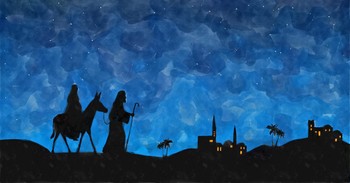
On this day, December 24, 1968, the spacecraft Apollo VIII, carrying James A. Lovell, William Anders and Frank Borman became the first manned vehicle to circle the moon. The three orbited the earth's satellite 10 times before firing their engines to head home. At their closest approach, they "skimmed" just sixty-nine miles above the desolate, gray surface.
During their ninth orbit, the astronauts sent photographs back to earth, describing their awe at the bleakness of the moon and the beauty of the earth. (Borman's photograph of a half earth hanging above the moon's horizon is the most famous shot ever taken from space; the postal service printed it on a stamp.) All three astronauts commented on the colorlessness of the moon.
In his autobiography Countdown, Frank Borman later wrote, "There was one more impression we wanted to transmit: our feeling of closeness to the Creator of all things. This was Christmas Eve, December 24, 1968, and I handed Jim and Bill their lines from the Holy Scriptures."
About six weeks before launch, a NASA official had called Borman. Noting that the crew would be circling the earth on Christmas Eve, he said, "We figure more people will be listening to your voice than that of any man in history. So we want you to say something appropriate."
Without time to research the question himself, Borman appealed to his friend Si Bourgin, a NASA employee. Bourgin posed the question to Joe Laitin, formerly a United Press International reporter. Laitin's suggestion pleased Borman. He had the words typed on fireproof paper. For the men, homesick for earth, the chosen words could hardly be more appropriate.
Bill Anders read Genesis 1:1-4. "In the beginning God created the heaven and the earth. And the earth was without form, and void; and darkness was upon the face of the deep. And the Spirit of God moved upon the face of the waters. And God said, 'Let there be light:' and there was light. And God saw the light, that it was good: and God divided the light from the darkness."
Jim Lovell took the next four verses. "And God called the light Day, and the darkness he called Night. And the evening and the morning were the first day. And God said, 'Let there be a firmament in the midst of the waters, and let it divide the waters from the waters.' And God made the firmament, and divided the waters which were under the firmament from the waters which were above the firmament: and it was so. And God called the firmament Heaven. And the evening and the morning were the second day."
Frank Borman finished with, "And God said, 'Let the waters under the heaven be gathered together unto one place, and let the dry land appear': and it was so. And God called the dry land Earth, and the gathering together of the waters he called Seas: and God saw that it was good."
As the men completed the orbit, Lovell said, "I don't know who your two friends were, but they sure hit the target."
Seven months later, Americans landed on the moon.
Bibliography:
- Borman, Frank with Serling, Robert J. Countdown; an autobiography. New York: William Morrow, 1988.
Last updated June, 2007



